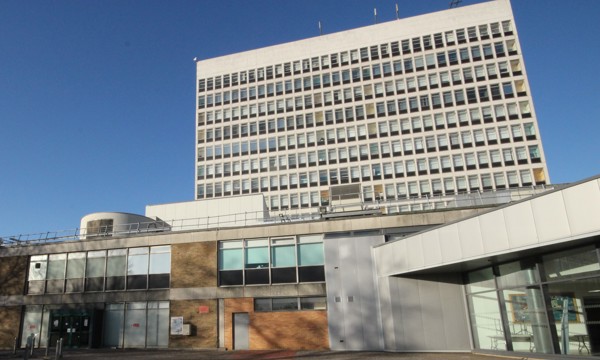Two buildings of Victoria Hospital in Kirkcaldy have been listed by Historic Environment Scotland (HES) in recognition of their special historic and architectural interest, it was announced today (Thursday 14 July).
The Phase I Block, which has been listed at Category C, was the principal building in the initial phase of the transformation works for Victoria Hospital. Designed by the Architect’s Department of the South East Regional Hospital Board, and built between 1956-8, the block was executed in the Modernist style using non-traditional building materials and methods, representative of the new type of hospital building that emerged in Scotland in the early post-war period based on a design philosophy of science, function and open-ended planning. Its canopied roof deck is of particular special interest, as a rare surviving example in the context of a Scottish hospital.
The Phase II block, comprising of the tower and podium, has been listed at Category B. Built between 1962-7, it was the primary building in the second phase of the hospital’s post-war expansion, and is significant as one of the earliest examples of high-rise hospital design in both Scotland and the UK.
Both buildings reflect the substantial social and economic changes that occurred in mid-20th century Britain following the introduction of the Welfare State, as the provision of suitable hospital buildings became a principal concern. The contrast between the two buildings also demonstrates the evolution of Modernism in post-war Scotland, illustrating the rapid pace of developments in hospital design from the mid-1950s to the mid-1960s.
Dawn McDowell, Deputy Head of Designations at HES, said:
“The post-war period saw a shift in hospital design in Scotland, whereby Modernism in architecture sought to directly equate with improvements in health care.
The two phases of buildings at Victoria Hospital are significant examples of this Modernist design ethos, through which we can gain an insight in to the changing attitudes in medical treatment and patient care that were occurring at the time. As significant examples of their building type, style and period, they have now been added to Scotland’s List of buildings of special architectural and historic interest.”
Neil McCormick, Director of Property and Asset Management at NHS Fife, said:
“We take great pride in the rich history of innovative design and development at the Victoria Hospital site in Kirkcaldy.
“Over the years the use of our hospital buildings has evolved greatly, with them being redesigned and repurposed to reflect the changing demands of best practice in modern healthcare.
“The listing of Phase I and II of the Victoria Hospital allows us recognise the rich history of these buildings and retain the external modernist design, while still enabling us to continue to evolve the buildings internally to ensure they remain fit-for-purpose.”
HES lists buildings of special architectural or historic interest that help to create Scotland’s distinctive character, and through which we can discover more about the stories of our past. All designation applications are researched and assessed by a dedicated team.
For more information on the designations view the Phase I and Phase II blocks.
About Historic Environment Scotland (HES)
- We are the lead public body charged with caring for, protecting and promoting the historic environment. We will lead on delivering Scotland’s first strategy for the historic environment, Our Place in Time.
- Historic Scotland, Scran, Canmore, The National Collection of Aerial Photography (NCAP), The Engine Shed, Stirling Castle and Edinburgh Castle are sub-brands of HES.
- View our press pack and keep up to date by registering for media release email alerts. If you wish to unsubscribe, please contact us.
Follow Historic Environment Scotland
Twitter: @HistEnvScot | @welovehistory
Facebook: @HistoricEnvScotland | @VisitHistoricScotland
Instagram: @HistEnvScot | @historicscotland
For further information, please contact:
Claire Mullaney
Historic Environment Scotland Media Office
Mobile: 07221 959 962
communications@hes.scot

